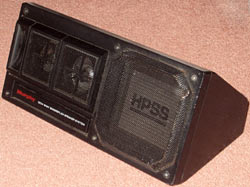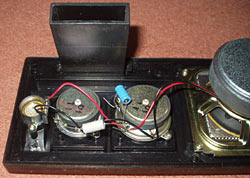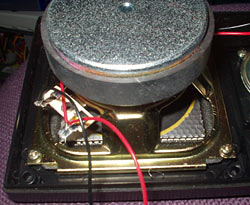
Dan's Data letters #11
Publication date: 18-Nov-2002.Last modified 03-Dec-2011.
Shims, and diddly
A friend of mine and I are arguing about whether making an Athlon shim out of copper will do diddly (he says) or not (I say). As far as we can see, it comes down to whether or not the organic substrate of an XPyaddayadda+ conducts any heat or not.
My suspicion is that even if it gets warm, it's still nowhere near as hot as the base of the heat sink, so even if there is any heat conduction it'll be the wrong way. I am however forced to yield to his claims that without thermal imaging equipment, I'm really just pissing in the wind saying that.
What do you reckon?
Richard
Answer:
Shims are not for cooling. They're to stop badly designed CPU coolers from
crushing CPUs. Ever since Athlons have come with those little rubber dots
on them, shims have been unnecessary, unless you're using a really
unsuitable CPU cooler.
Shims also have very small thickness tolerance; if they're too thin they won't do anything at all, and if they're too thick they'll prevent the CPU cooler from touching the CPU at all in the middle, where it's meant to.
Since a shim reduces the contact pressure between the CPU core and the heat sink, it reduces heat transfer there, especially if you use too much thermal transfer compound, as most people do. With decent contact pressure, a moderately excessive amount of thermal grease isn't much of a problem, as far as I can see.
The casing of the CPU needs no cooling at all. If your CPU temperature sensor is one of the under-the-socket types that touches the CPU casing, then installing a shim may give you a lower number, because now the casing will be cooler. The core will probably be hotter, though.
About the best you can hope for from using a shim on a rubber-dot-equipped Athlon with a half-decent CPU cooler is no improvement at all.
Sound nuts
I remember, many years ago, an ad for a marker pen to darken the edges of your CDs, to stop reflected light from escaping. Apparently you lost high frequency music this way!
I won't bother pointing out the on/off nature of digital encoding, and that a high-frequency digital signal is exactly the same as a low frequency-signal, all encoded at 44.1KHz. Anyway, a quick search on the Net on this 15-year-old subject netted me several links. Unbelievably, in this enlightened age, people are still doing this!
I found this ad as well.
Richard
Answer:
It was never entirely clear what, exactly, colouring around the edges of
a CD was meant to achieve. The idea was and is basically incoherent, of
course, because in order to encounter the pigment you'd added to the outside
of the CD, the light would have to have been leaving the CD anyway; only
if by some freak chance it managed to be reflected back to the pickup by
some shiny object inside the CD player could it possibly have any influence
on anything.
Tweaky audiophiles don't think too hard about this stuff, though; like the most enthusiastic kinds of alternative medicine believers, they deny their own foolability and believe in anything that seems to "work". David Copperfield seems to make the Statue of Liberty disappear, but for some reason audiophiles do not generally believe he really does it.
The page you mentioned has either been written by someone really, really out there, or it's just satire. Stuff like "This water based polish will smooth the rough edges on the pits..." ought to mark it as clearly being a joke. But, unfortunately, the audiophile world is full of people who pay thousands and thousands of dollars for obvious jokes.
Mail preservation
I need to reinstall Windows from scratch, as you describe on your site. Can you please tell me how I can back up Outlook and Outlook Express emails? That's about the only thing I can't figure out.
T.J.
Answer:
Step 1: Don't use Microsoft e-mail software.
Step 2... what? You're ALREADY using Microsoft e-mail software?
Bummer.
Microsoft e-mail clients keep all of their messages in gigantic files of a format that nobody else uses. *.DBX files are Outlook Express mailboxes, *.PST files are Outlook mailboxes; both should be copyable from your old installation directory to your new one, and Outlook even has an import/export option (in the File menu) that lets you export your mail to a file, then import it into another Outlook install later.
To move Outlook Express mail from one machine to another (on NT/2000/XP machines, anyway), run Registry Editor (Start -> Run, and type "regedit"), look in HKEY_CURRENT_USER, right-click Identities, and Export it to a file. Call the file oe.reg, say.
Now locate your Application Data\identities directory on your hard drive; it'll be in Documents and Settings\[your login name]. Back it up.
Take the backup, and the oe.reg file, to the new machine. Restore the Identities directory to the same place it was in on the old machine, and double-click the oe-reg file. Now your mail ought to be transferred.
You may also find Express Archiver helpful, if you want to avoid doing Outlook Express mail backup by hand. This page may also help you find the mail files.
One reader of this page has pointed out that you can just, within either Outlook flavour, select all of the mail you want to back up and drag it somewhere; it'll land as a bunch of .msg files, which you can drag back into another copy of Outlook-whatever. You can't copy directory structure this way, but it's a simple way of backing up any block of messages that you can easily group-select.
Driver hunting
In step 3 of your reinstallation guide, you suggest getting in the habit of sticking driver software on the hard drive.
Question: Is there an easy way to search for these drivers that are presently in use (as well as others that may also be on the hard drive) so that they can be backed up before reinstalling Windows?
J.D.
Answer:
Well, lots of drivers are just files in your windows\inf subdirectory; keeping
your old Windows directory when you reinstall keeps that subdirectory as
well, and if you can't find the original driver CD or floppy, just searching
for a driver in the old inf directory may save you from hunting around on
the Web.
Driver installers commonly deliver more stuff than that, though, which you may or may not be able to manually hunt up in windows\system and windows\system32 and so on. Not to mention whatever registry changes they may make. Really, you want the original install directory; there's no simple way to reconstruct it from a system that's got the driver installed.
Battery-less flashlight?
I have a bug catching, curious four-year-old boy who loves torches but plows through batteries like no-one's business. I hear you can get LED lights that use Faraday's principle and not batteries. He has plenty of shake, so I wanted your recommendation on which would be best. Sharper Image sell one for $US29 but it looks to be pretty big for the little fellow, and Real Goods sell one for $US85 - I THINK NOT!
Clare
Answer:
Coincidentally, I've got a NightStar "ShakeLight"
on my to-review pile at the moment [UPDATE: And I reviewed it,
here].
It's $US39 for a pretty dim light, and it's quite big (which, as you say, may be a problem), but it seems to be as tough as they say it is; even a four year old will probably not be able to destroy it quickly.
I've no idea whether the cheaper Sharper Image light is any good. Most, if not all, of the $US75-plus shake lights are NightStars; they're just being sold by someone else, with a fatter profit margin.
Speaker options
After reading your M4 speaker kit review, I thought you might be interested in a different kit I've come across that looks to offer many advantages over the M4s -prebuilt cabinets, silk dome instead of Mylar tweeters, substantial 6.5in woofer, and perhaps most importantly, a full second-order custom crossover with audio-grade components. It sells for about $AU250 AUD for a pair, or so my currency converter tells me - it's $US139.80. Shipping from the States might kill the idea, though.
Brian
Answer:
As I said in the M4 kit review, there are quite a lot of places around the
world that sell speaker kits, and pretty much all of them are very good
value for money. where The kit you
mention looks fine, but it's not an option for Aussie buyers, or pretty
much anyone else outside North America; the listed net weight for
the pair of speakers is 35 pounds. Assume 40 pounds gross weight, and the
shipping fees are likely to be more than twice the purchase price.
DHL, for instance, will deliver a 40 pound
box to Sydney, Australia for a mere $US330. The cheapest
USPS air mail fee for a 40 pound box
to Australia is about $US170; if the package weighs 45 pounds or more, though,
it's $US280.
The Parts Express kit may well, however, be of interest to my next correspondent...
Cheap surround?
I read your review of the M4 speakers, and I though that I could buy some kind of speakers kits like these, an amp and a sub and just plug that to my computer and my DVD system.
I live in Canada; do you know of any vendors that specialise in speaker kits in North America?
I also want to know a little bit more about speakers. Right now I have a 20 year old amp with speakers about as old on my computer, and, well, anything not bass or midrange sounds. If I buy new speakers I really want at least a 4.1 kit, and I would like to have something more than things made only for the computer, since I listen to a lot of music and want to use them with the DVD player.
What would you buy if you were me with about 600 Canadian dollars (about $US375) to burn?
Psycho1024
Answer:
Well, as mentioned above,
these look good. There are lots of other options, though; just do a
Google
search for "speaker kits" and most of the results will be from the USA.
I don't have any personal knowledge about the quality of any of these products,
but just to give another example,
Speaker City have some promising looking kits that start at reasonable
prices.
The budget you've got is rather tight for what you want to do. But you could retire your existing speakers into surround duty, buy used speakers (at a garage sale, on eBay...) for the other non-sub channels, drop the rest of your money on a used surround receiver, and then save up for a subwoofer.
More speaker-talk
Loved the article on the product from theloudspeakerkit.com, so much so that when I came across some old broken speakers I decided to have a crack at something similar. Living up north in Blighty I'm just a short way out of the metropolitan Sydney delivery area, so I'll have to make some cabinets myself.
The speakers I've acquired are some old car stereo speakers made by none other than "Murphy" (God only knows who they are, Google turned up nix).
They are four-way units, with drivers of questionable origin. A small sticker claims "MAX: 120 WATT 4 ohm" and a couple of the drivers have "4 ohm" stamped on their backs.
There is also some kind of noise damping material in the case behind the bass driver, and a big oblong port that you can see in the photos I've attached.
The electronics seem to be pretty flash too, nothing resembling a crossover, but the two intermediate drivers have capacitors wired across them. I was intending to keep the electronics as it is now anyway, and just installing it all in the new case. My main question is, will 4-ohm speakers be OK to run from my hi-fi? My current speakers are 8-ohm.
And, as a bonus question - the bass driver makes huge marketing claims of "HPSS : Honeycomb Plane Square System", and seems to be a circular driver with a square thing glued on the front (looks like corrugated cardboard). Any idea what that's all about?
Tom
Answer:
Four-ohm speakers should be fine with your existing amplifier. They'll play
louder for a given volume knob setting, but unless your amplifier is very
exotic or very old, it should have no trouble at all.
The "HPSS" stuff, I've seen before. Cheap and nasty, basically; the flat front is good in theory but bad in this implementation, adding mass to the driver for no real result.
These are very cheap drivers. They'll work, but the bass driver won't deliver much bass, and won't be terribly efficient, with that goofy bit of plastic on the front of it. The tweeter's a truly 'orrible piezo disc with a rudimentary horn moulded into the front bezel. That's why it has no crossover; piezos don't need one. The caps in series with and across the two middle drivers do count as a basic crossover, though.
Those two midrange/tweeters are only there because the over-weighted bass driver can't stretch up as far as it'd be able to without the silly honeycomb on its front, and the little piezo has no midrange extension, leaving a frequency response hole that needs another driver (or two, in this case) to fill it.
A slightly-well-designed speaker with two half-decent drivers will sound a lot better than this one with four.
Frankly, I think you'd hear much better results if you dropped a couple of six-by-nine-inch oval car speakers into the boxes you're making.






